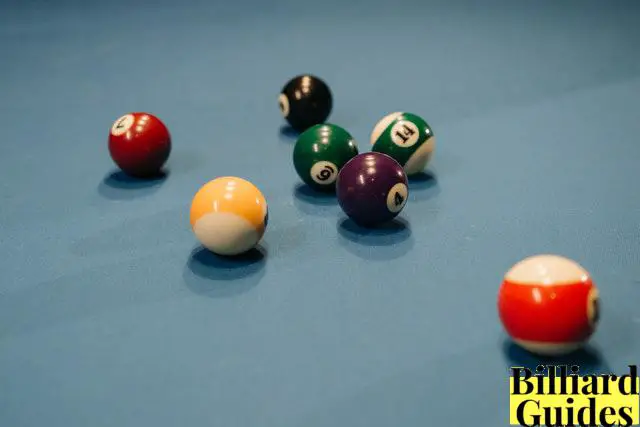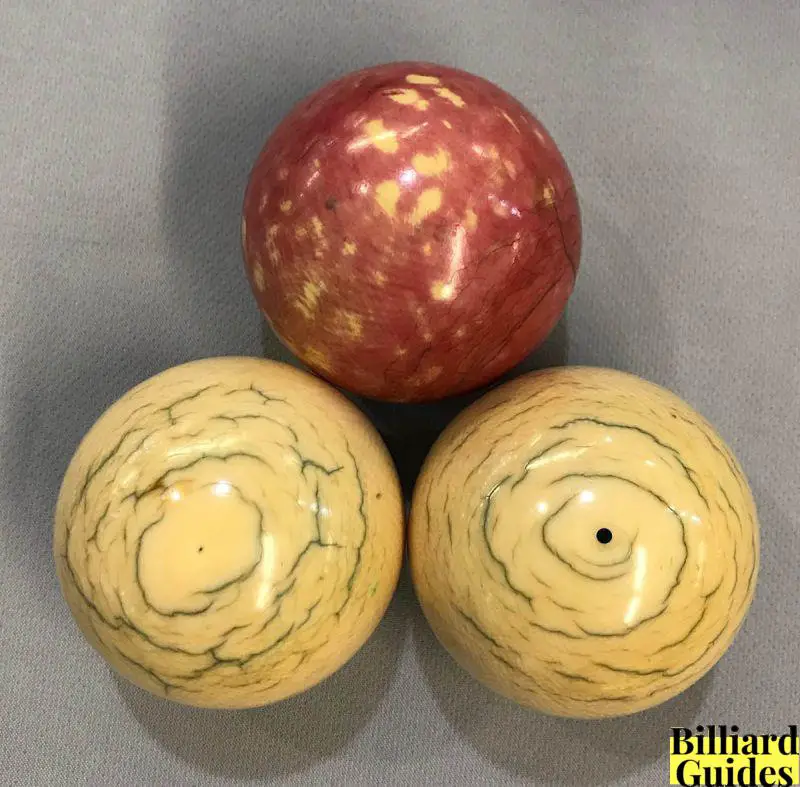It’s not surprising if you ever had the thought about what billiard balls are made of and if you’re a beginner player, it is still a practical question. But here’s a thing, different Brands are making them out of different materials and there is a lot of history.
Most of the Billiard balls (probably 85%) are developed by one company named Saluc. More brands named Aramith, Brunswick Centennial, are manufacturing different material pool balls. In Today’s article, we will be discussing the materials of Billiard balls.

What are Billiard Balls?
Billiard balls are hard, round, and small and used in Cue sports. They come in different colors and numbers. Sports named snooker, carom billiards, pool use the same kind of balls.
Pool balls are used in many games such as eight-ball, nine-ball, straight pool, etc. There are various kinds of pool balls that are available. The World Pool billiard Association showed average equipment specifications of billiard balls. The average weight is 5.5 to 6 Oz. Probably 160-170 g. And the diameter is 57mm, plus or minus 0.005 in (0.127mm).
Evolution through the history
The game of Billiards has a prosperous history and they used to play by different types of balls. The sport first evolved from a lawn game in the 13th century. Since then the balls have gone through various changes till 2021.
The first billiard balls were made out of stone. But the stone-made balls were heavy and difficult to play with. Then creators made wooden balls. Which didn’t last long. Eventually, in the 16th century, the stone balls were replaced by Ivory pool balls and they were the best natural material to play with.

In the 20th century, the balls made with Ox Bone became popular in Europe. There was a written reference in the Inventory of the Duke of Norfolk about Ivory Billiard balls in 1558.
Since then, Elephant Ivory balls were favored till the 20th century. The elephant tusks were the symbol of Luxury and Wealth. Around the early 1700s, inventors made dyed and numbered billiard balls. But after some time, they had to stop manufacturing elephant ivory balls because of the dangerous effect on Environment.
The elephants were endangered and only 8 balls would be made out of one elephant tusk. It was difficult for the inventors to continue manufacturing elephant ivory balls. By the mid 19th, they stopped making ivory balls and came up with alternative material.
The billiard industry was falling. Inventors were anxious. Then The Phelan and Collender Company, a manufacturer of billiard accessories, came up with a notion. They launched a competition offering a prize of $10,000.
John Wesley Hyatt came up with a different composition material named Nitrocellulose in 1869. It was the first American patent for billiard balls that commercially branded celluloid in 1870. Which was a mistake for the brand. There was a time when balls could explode during playtime. The effect was very dangerous and Harmful.
The reason they used to explode is because of the material they used. They made the pool balls with a substance named Celluloid, an early plastic that was Combustive. Celluloid origin was far back from the American civil war.
After celluloid, the inventors started experimenting with different kinds of materials. The industry Experimented with synthetic materials also crystallite and other plastic materials. It didn’t take time for the creators to come up with a distinct kind of pool balls. And the billiard balls we are using today are the material that inventors created.
What are Billiard Balls Made of Today?
The most common elements are Phenolic and Resin, also sometimes plastic. Let’s see how they work –
Phenolic Balls
The chemist Leo Baekeland invented Bakelite which is a type of Phenolic Resin. Nowadays Phenolic Resin balls are manufactured in most countries. It is the most popular and Budget-friendly Billiard Balls. Phenolic Resin Balls Last up to five times longer than other materials Balls.
The average life expectancy of Billiard Balls is Two to Three years. It depends on how often you play and how often you clean your Billiard balls.
Phenolic Resin balls hold their gloss polish and give less friction between the tablecloth and the ball. It is resistant to heat and offers a stabilized material with homogeneous density. The balls are cheap and great for pool play.
Resin and Plastic
Other Alternatives are available. Today billiard balls are made with a combination of Resin and plastic. Sometimes Acrylic Billiards balls are also used for playing. The materials are moldable and dense. The best billiard balls are made in Belgium. The company named Saluc makes Phenolic resin Billiard balls which are world-famous. Aramith also manufactures phenolic resin Balls.
Tips to choose the right billiard balls
Here are some things you should keep in mind before buying billiard balls. Not all brands will give you the same quality balls you want. That’s why here’s a buying guide for billiard balls.
- Density: The right amount of Density of billiard balls is 2.5g cm^3. If you don’t get the perfect density, your ball won’t roll straight. And you can’t give a perfect shot.
- Roundness: Roundness is very important. It is the most vital figure for a billiard ball. Cheap balls won’t give you the ultimate perfect roundness. You need to choose high-quality billiard balls.
- Surface Polish: A glossy polished Billiard ball will give you the ultimate smoothness. If your pool ball is not polished then the friction between the balls and the table cloth might tear the cloth. Also, non-polished billiard balls don’t last long.
- Colour precision: cheap billiard balls colour will come off after few days. Make sure to choose billiard balls that are painted with High-quality colours.
And many more things like balance, diameter tolerance, weight, etc make influence your game. Make sure to buy high-quality billiard balls to avoid buying frequently.
Final Thoughts
Billiard balls are revolutionized our Environment. From dangerous celluloid to Resin plastic, every material affects our environment. Pool game lovers are very specific about their pool balls and their Quality.
However, we need to recycle these balls and make our environment healthy. How billiard balls are made will give you an idea of materials and statistics about billiard balls.
Make sure to comment down below what topic you want next about billiards.
Interesting Articles to Read